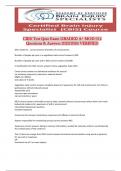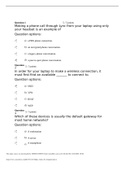CBIS Test Quiz Exam GRADED A+ MOD 012
Questions & Answers 2023/2024 VERIFIED
DOC stands for... correct answers Disorders of consciousness
Number of people per year in a vegetative state correct answers 4,200
Number of people per year with a DOC correct answers 315,000
3 classifications for DOC correct answers Coma, vegetative state, MCS
Coma correct answers no behavioral evidence for arousal
no voluntary response to internal or external stimuli
Might see reflexes
lasts about 2-4 weeks
Vegetative state correct answers complete absence of awareness for self and environment, but there is
spontaneous stimuli-induced arousal
sleep/wake cycle
eyes are open sometimes
can last months or years
MCS correct answers minimally conscious state; severely altered consciousness where there isn't much
behavioral evidence for awareness of self or environment
intermittent behavioral reactions
localized responses
Arousal correct answers involuntary responses and reflexes to external stimuli
System responsible for maintaining arousal correct answers RAS
Awareness correct answers taking in sensory information; needed for voluntary actions; coordinated by
the cortical areas of the cerebrum
The 2 criteria to emerge from DOC correct answers functional communication using words or gestures
for yes and no responses
OR
functional use of 2 or more objects
,Central apnea correct answers lack of signals from the brain to the muscles that control breathing
Metabolic distress correct answers abnormal hormone responses that lead to increased energy demands
Dystonia correct answers involuntary muscle contraction that causes slow, repetitive movements or
abnormal postures; extreme tone or stiffness
Goals for medical management of DOC correct answers maintain physical stability in order to participate
in daily life as much as possible
prevent medical complications
provide opportunities for stimulation to the neurological system
Challenges for medical management of DOC correct answers Skin breakdown, respiratory issues, bowel
or bladder dysfunction, autonomic dysfunction syndrome
Skin breakdown due to DOC correct answers pressure sores, friction related irritation, bowel and bladder
incontinence, pressure from splints and braces
Respiratory issues from DOC correct answers dependence on a trach, sleep apnea (obstructive or
central), tracheal aspiration (entry of foreign matter)
Bowel or bladder dysfunction due to DOC correct answers incontinence, constipation, bowel
irregularities, discomfort, infections (C Diff or UTI), hygiene and skin issues
ADS correct answers Autonomic dysfunction syndrome; dystonia, agitation, tachycardia (rapid heart
rate), diaphoresis (sweating), hyperthermia, hypertension, tachypnea (rapid breathing)
Incidence of ADS correct answers 15-33% of people with a severe TBI
Treatment for ADS correct answers environmental control, pharmacological interventions,
pharmacologic neuromodulation (using medications to change arousal and awareness, like anti-
depressants, dopaminergic agents, ADHD meds), treatment planning
Neurobehavioral assessments of DOC correct answers bedside neurobehavioral evaluations; let's the
rater see what needs more improvement and what is doing well over time
Bedside neurobehavioral evaluation examples correct answers GCS; Coma/near Coma scale. Coma
Recovery Scale, disorders of consciousness scale, sensory modality assessment and rehabilitation
technique, sensory stimulation assessment measure, Wessex head injury matrix, Western neuro-sensory
stimulation profile
, Challenges of bedside neurobehavioral evaluations correct answers medications used to treat BIs can
adversely effect alertness and arousal; complications with other things could effect a person's ability to
respond to assessment measures; discrepancies in capacity and performance; communication and
cognitive deficits could cause discrepancies
Goals for DOC treatment correct answers sensory stimulation and regulation; physical management
Sensory stimulation and regulation for DOC goals correct answers still not clear if there is enough
evidence to show that people in a coma or vegetative state can sense sensory information; otherwise,
important to present stimuli one at a time to allow extra time for responses, and need to vary what
stimuli is presented. Don't over do it and get the family involved.
Goals for sensory stimulation and regulation for DOC correct answers increase arousal by stimulating the
RAS; prevent sensory deprivation; increase response frequency; facilitate the ability to follow commands
Physical management for treatment of DOC correct answers musculoskeletal system goes through a lot
of changes as far as bone density, muscle structure, and ligaments and tendons being contracted
Interventions for physical management of DOC correct answers daily range of motion; maintain and
increase range of motion through orthotics; keep someone in an upright position, and check their bed
positioning
Why is upright positioning so important when dealing with someone with a DOC? correct answers
maintaining bone density, normalizing body functions, and enhancing alertness due to the effect on the
RAS
Why is bed positioning so important when dealing with someone with a DOC? correct answers Reducing
skin breakdown and pressure ulcers
Percent of people in the US living with a long term disability due to a BI correct answers 1.1-1.7%
Cardiopulmonary and vascular complications due to BI correct answers increased mortality and
morbidity
needing a tracheostomy initially
dysautonomia
DVT
Dysautonomia correct answers issues regulating temp, BP, and perspiration
autonomic storming
muscle inactivity, posturing issues, dystonia, rigidity, and spasticity





